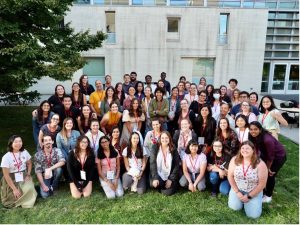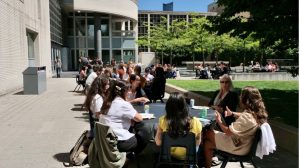This post is a collaborative effort, written by the ComSciConCAN2022 organizing committee: Katie Pullella, Ben Davis-Purcell, Shealin Murray, Shanzeh Mumtaz Ahmed and Francesco Zangari.
When the inaugural ComSciConCAN took place in 2019 at McMaster University, it emboldened Canadian graduate students to share their science beyond a traditional scientific conference. The results were astounding. It was obvious the event needed to continue and grow to reach more participants. This led to the spawning of local workshops in conjunction with a national one.
Then the COVID-19 pandemic happened and the next two ComSciConCAN events were held virtually. While successful, these just weren’t the same and lacked the energy and spark that we experience when we’re together in person.
After a two-year virtual hiatus, ComSciConCAN returned on August 12th-14th at the University of Toronto.. The three-day event featured panels, workshops, pop talks (one-minute elevator pitches on the attendees’ research), special sessions (more on these below), networking events, and even a science improvisation session.
The enthusiasm witnessed at the inaugural event was back, with the organizing team receiving over 400 applications from nine provinces. In all, 48 students from 18 institutions in Canada attended the conference with minimal cost to them. ComSciConCAN offers accepted applicants travel and living cost reimbursements through funding from our sponsors, who generously invest in Canadian science communication training.
The conference fittingly kicked off with a “bang” thanks to our keynote speaker Dr. Katie Mack, cosmologist, science communicator, and author of The End of Everything: (Astrophysically Speaking). Mack, the Hawking Chair in Cosmology and Science Communication at the Perimeter Institute for Theoretical Physics, used her astrophysics expertise as a backdrop for lessons in effective communication. She stressed that facts are necessary, but not sufficient: to reach our audience, we must connect at a personal level through emotion, storytelling, humour and, if possible, by providing “eureka moments.” Mack also emphasized that building a community, like on Twitter where she is a popular science communicator, is essential. The keynote was not only entertaining but filled with actionable science communication advice. However, the fun and learning did not stop there; each workshop and panel provided invaluable lessons that we summarize here:
Communicating With Diverse Audiences Panel: For our first panel, we welcomed Penína Sara-Lynn Harding (PhD candidate at the University of Northern British Columbia), Dr. Imogen R. Coe (professor of chemistry and biology at Toronto Metropolitan University) and Dr. Anthony Bonato (professor of mathematics at Toronto Metropolitan University). The discussion spanned a wide range of topics and included enlightening anecdotes and perspectives of lived experiences from the panelists. Key themes that emerged from the Q&A included valuing science communication (and by extension equity, diversity and inclusion efforts) as equal to scientific research; learning to own your personal biases (we all have them!); and continuing to challenge gatekeepers. The most common quote that our attendees shared with us following the panel was “diversity is a fact, inclusion is a choice,” which led to discussions on ways to bring that mentality forward with them as they pursue new avenues of science communication.
Science Improvisation: Vinny Francois (Improv College), and Dr. Katie Pagnucco (biology professor at John Abbott College) are professional improvisers, science educators and co-hosts of the LearnRealGood podcast. They led our interactive science communication improv workshop, taking attendees through a series of group activities culminating with a laugh-out-loud storytelling event during the partnered “Yes and…” scenario game. Francois and Pagnucco offered many parallels between science communication and improv, including having confidence when speaking and converting mistakes into (often humorous) lessons.
Data Visualization: Mark Belan (artsci studios) kicked off the second day sharing best practices in communicating science through visuals and art. Since scientific data are often complex and difficult to digest, scientists need to reduce the cognitive load required to interpret findings. Belan explained that while there is a temptation to mention each element in a visual, constraint is needed to maintain salience and functionality. One key point he emphasized was not to make a painbow. Instead, Belan highlighted an iterative process termed “baking a visual” for image design:
- Understand your customer/audience (e.g., physicians, graduate students, etc.).
- Select your ingredients (e.g., colour palettes, typography, orientation, etc.).
- Make the cake (e.g., your intended visual)!
Communicating Through Science Policy & Activism: Dr. Amita Kuttner (Interim Leader of the Green Party of Canada), Farah Qaiser (Director of Research and Policy at Evidence for Democracy) and Dr. Love Ese-Chile (COO at Regenerative Waste Labs) led our science policy panel. As these experts have backgrounds in politics, academia and industry, it made for a powerful discussion on science communication efforts through the lens of science policy. The panelists first discussed how best to describe science policy, arguing that the definition begins with evidence-based decision-making to aid the community. Qaiser stressed that there are two angles that must be considered: science for policy (e.g., the number of COVID-19 cases informing public health decisions) and policy for science (e.g., policy to guide science towards more equitable means).
While both science and policy are intertwined, the connection, or lack thereof, between scientists and policymakers represents a relationship that needs mending to achieve an equitable and positive future. One clear example was the disconnect during the COVID-19 pandemic, where the focus should have been on comradery and coming together, but instead shed light on the lack of unity between governments and scientific institutions.
The responsibility belongs to all science communicators to learn how to amplify the voices of those being impacted by political decisions. Panelists agreed storytelling is important, but equally important is knowing your audience to bridge gaps. Kuttner ended the panel on a hopeful note, by reminding the audience that despite the ongoing global crises, it is crucial to picture a better world and recognize that we can reach this goal together.
Indigenous Storytelling: With an emphasis on telling scientific stories across the landscape, amplifying, and including Indigenous perspectives needs to be a focus moving forward in our science communication efforts. Aaron Kilmury (graduate student at the University of Manitoba), and Dr. Maureen Matthews (Curator of Cultural Anthropology at the Manitoba Museum), led a workshop sharing their experiences and recommendations on how to incorporate Indigenous voices within science and everyday life. Kilmury focused on inclusion and representation through the lens of Earth Science. He shared ways to improve representation by involving communities in research plans, along with valuing transparency to facilitate communications. Matthews detailed her efforts to support Indigenous land acquisition and get it recognized as a world heritage site by UNESCO. An important point to keep in mind when incorporating Indigenous ways of knowing into science communication is that not all stories and knowledge are to be shared by just anyone. There are significant protocols in place to protect and honour Indigenous knowledge that settlers must respect.
Misinformation Workshop: We wrapped up our weekend with a workshop delivered by Dr. Krishana Sankar (Science Advisor and Community Partnership Lead with ScienceUpFirst). ScienceUpFirst is a national initiative focused on combating the spread of misinformation. Sankar led an engaging session about the difference between misinformation and disinformation, as well as how to identify and fight false claims. Surprisingly, most disinformation shared during the pandemic was popularized by approximately twelve people on social media. One of the main reasons disinformation can spread so easily can be traced back to limited science literacy coupled with inaccessible and/or unclear messaging from trusted authorities. Given the rise of misinformation on social media, Sankar provided effective strategies for identifying posts with inaccurate messages and highlighted key ways to address the inaccuracies online. According to Sankar, to battle misinformation you must first share accurate information (don’t make your headline the misinformation!), debunk the misinformation in question, and always focus on educating the public.
Networking (Careers Dinner, Create-A-Thon and Show & Tell): This year’s event featured many opportunities to meet, mingle, learn and connect. At the Careers Dinner, attendees made connections with guests from the Gairdner Foundation, Discovery, Toronto Science Policy Network, RCIScience and other local groups. The Create-A-Thon paired attendees with science communication experts in their field to get feedback on a piece they had workshopped several weeks prior to ComSciConCAN. These pieces can take any medium—from a blog post, to an Instagram reel, to an infographic or even an escape room. The experts shared their advice on how to make pieces stronger, while providing suggestions for where to publish.
A highlight of the weekend was the inaugural “SciComm Show & Tell,” where attendees shared their science communication initiatives with the rest of the group. We heard about regional initiatives, including CitiSchools, planetarium programming, museum exhibits, and saw ideas come to life on the big screen as a documentary.
After three full days, we wrapped up ComSciConCAN 2022 with an exchange of phone numbers, Twitter handles and promises to keep in touch. One of the most fulfilling aspects of the conference was watching connections grow and hearing about planned collaborations. Although the programming and presenters were diverse, one theme emerged through the weekend: empathy and compassion must be at the centre of everything we do. As Mack said, we are humans talking to humans about being human!
If you are a Canadian graduate student interested in expanding your science communication skill set, planning is already underway for our 2023 National meeting, and we would love to see you there! Follow us on Twitter for updates.
Resources: Interested in some of the tools and resources recommended during ComSciConCAN 2022? Mark offered Data Viz to explore different visual ways to represent your data. For reading, he suggested The Guild Handbook of Scientific by Elaine R.S. Hodges and also alternatives to Adobe Illustrator, found here, here, and here! Our Science Policy panelists suggested newsletters such as the Canada Gazette and those by organizations like Evidence for Democracy to help keep us informed about upcoming policies.









Comments